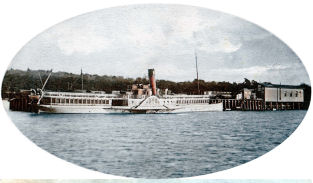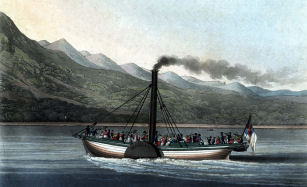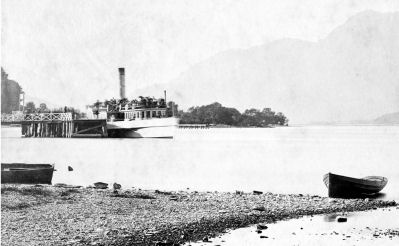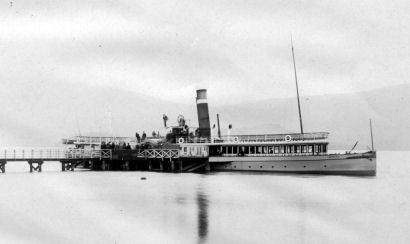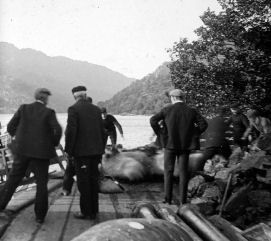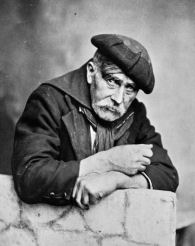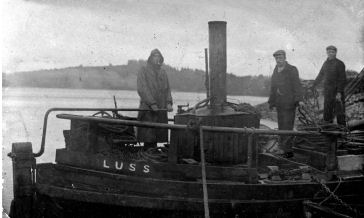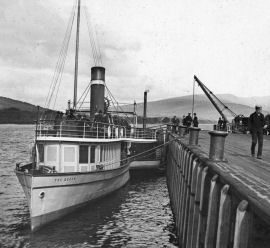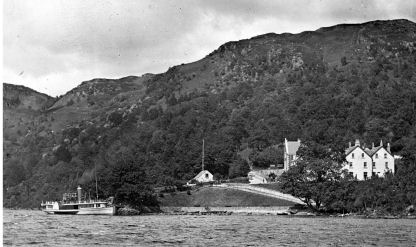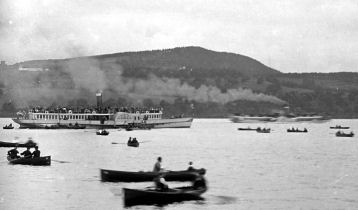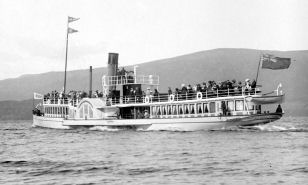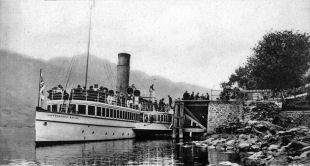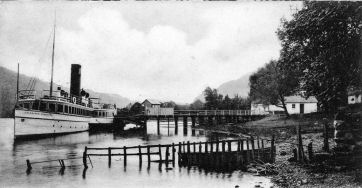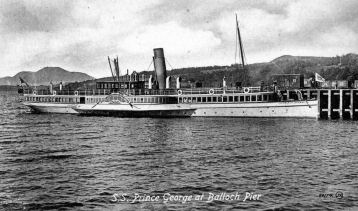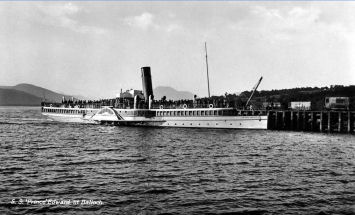The Loch Lomond Steamers
By A. Graham Lappin
NOTE: Enlarged versions of each of the images on this page can be seen by clicking on the images below. These will open up in a new window.
In 1816, just four years after the the Comet commenced her role as the pioneering steamboat on the Clyde, the engineer, David Napier, had a small steamboat built for himself. He named his little boat Marion, after his wife, and for just over a year she was well known on the Clyde. The publication of Scott's Rob Roy in 1817 had provided a great impetus to the tourist trade on Loch Lomond who were willing and able to pay for a premium service and the visionary Napier saw the potential for running his steamboat on the Loch. So, Marion made her way up the Leven in July 1818. The movement of Marion from the Clyde was noted by the local poet William Harriston who lived for a time in Dalvait and wrote in September 1818
“But wat ye where has Marion gane?
She wasna here this towmond;
Anither course has Marion ta'en,
She's cruizing on Lochlomond.”
The movement was also noted in August 1818 by Lord Jeffrey, later to become Lord Advocate who remarked; “It is a new experiment for the temptation of tourists. It circumnavigates the whole lake in about ten hours and it was certainly strange and striking to hear and see it hissing and roaring past the headlands of our little bay, foaming and shouting like an angry whale, but on the whole it rather vulgarises the scene too much, and I am glad that it is found not to answer, and has to be dropped next year.”
The Marion was a small craft just 60 ft long and she did survive her first year on the Loch. Her trade was unabashedly aimed at the tourist. Passengers were ferried to the steamboat at Balloch and she made her way up the Loch, calling at various hamlets where passengers might be rowed ashore by the ship's boat or a ferry boat. She connected at Inversnaid with passengers who would make their way to Loch Katrine and the Trossachs and would stop to allow passengers to see Rob Roy's Cave and Pulpit Rock which the furthest extent of her journey. Only one trip was possible each day.
The Marion was very successful and when a Mr. Egerton produced his lavishly titled account of a tourist trip from London to Loch Lomond in 1825 entitled “Airy Nothings; or, Scraps and Naughts and Odd-cum-shorts; in a Circumbendibus, Hop, Step and Jump by Olio Rigmaroll,” he included a painting of the steamer. While the painting is not very accurate, it does show some of the features of the trip, including a piper on board. A more accurate representation is given from a handbill and closely resembles the steamer painted by Joshua Cristall showing her disembarking passengers at Luss. During the winter, the Marion was generally laid-up in the lade of Levenbank Works and some of the crew found employment there also.
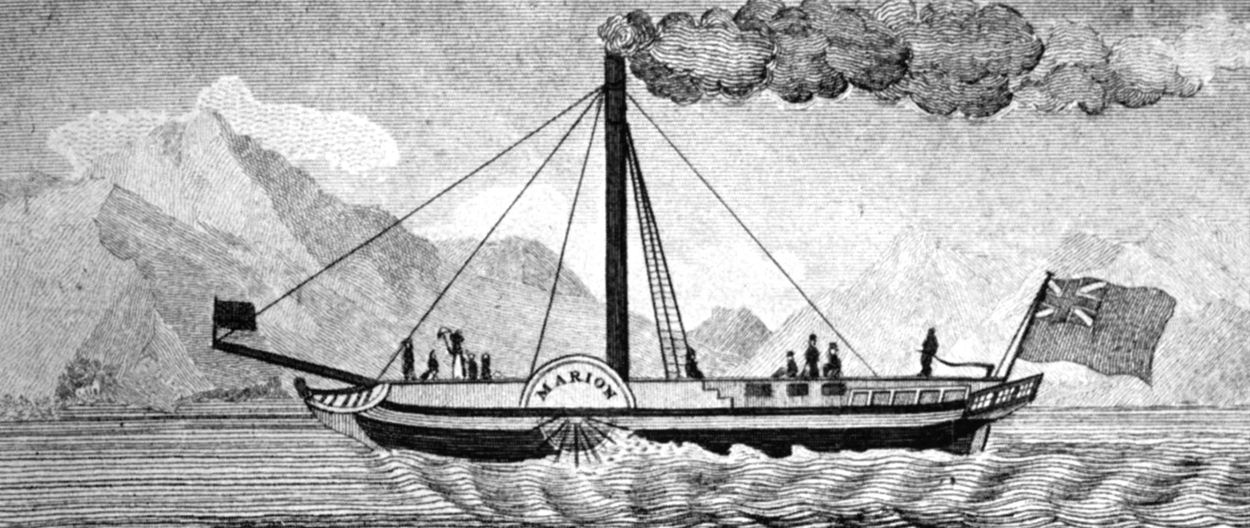
Marion from an advertising handbill
The Marion gained some competition in 1825 from a group of local business men, among them Adam Walker, proprietor of the Balloch Hotel, Donald M‘Lellan, proprietor of the Tarbet Hotel, John Bell of Dumbarton, John M‘Murrich of Stuckgowan, and Jonas Gildard of Tullichewan, who brought out a rival steamer, The Lady of the Lake. The new company, Lochlomond Steamboat Company, aimed to break Napier's monopoly and much competition ensued. Fares on the Marion were 7/6 first cabin and this was reduced to 3/- in the new steamboat. The normal journey from Glasgow involved taking the early morning Dumbarton steamboat to Dumbarton, thence by coach to Balloch. Napier shrewdly concluded an exclusive deal with the Dumbarton Steamboat Company forcing those for The Lady of the Lake to use an inferior charter.
In 1827 he replaced the Marion with the Euphrosyne, a larger steamer that had sailed on the Clyde as Post Boy. The upshot was that "The Lady" was offered for sale in 1828. She was bought out by John M‘Murrich who then entered a partnership with David Napier and "The Lady" was placed on the Clyde the following year. However, before she left the Loch, on 28th August of 1828, she was involved in a terrible accident. An overcrowded boat loading passengers at Tarbet capsized with 11 fatalities. An Edinburgh publican, Willison Glass, whose ale was said to be better than his poetry, commemorated the event with a poem, a few lines of which survive.
“One Miss Bunting, mild, discreet,
Who did belong to the High Street;
A widow-woman was there also,
Who did belong to the Rottenrow;
A doctor and his wife beside,
Who in Hutcheson-town did abide,
Enjoyed but two months of a married state,
For in Loch Lomond they met their fate.”
Trade improved in subsequent years and the Euphrosyne was joined by a second-hand steamer, Balloch, in 1835. She was most likely the Castle Finn, built for trade in Belfast in 1832 and purchased by Napier and M‘Murrich. The two steamers were scheduled with Euphrosyne taking the morning run and the new steamer sailing in the afternoon. A further challenge came in 1836 when an early iron steamer, Queen of Scots, was placed on the Loch. She had been built for service from Glasgow to Ayr but had insufficient framing from her amidships aft, and her overlapping plates gave this part of the ship a movement like a fish-tail in heavy weather so that she leaked badly, and indeed sank on more than one occasion.
It would seem the more placid waters of the Loch would be better suited to this craft but she proved unreliable and was finally withdrawn in June 1842. Napier and M‘Murrich also added a new iron steamer, Lochlomond, which took over sailings on August 1st in 1836. Both Balloch and Euphrosyne were offered for sale. Balloch was sold to work on the Clyde as Dumbuck in 1838 and Euphrosyne was sold shortly thereafter. Lochlomond was the last steamer built for Napier.
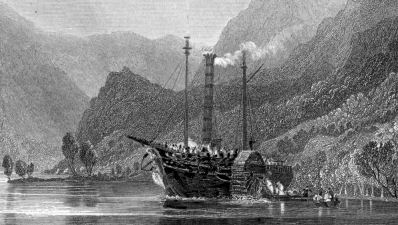
Engraving of a steamer loading passengers at the head of Loch Lomond
In 1844, a New Lochlomond Steamboat Company was formed and purchased a recently built Clyde steamer, the Waterwitch. Up until this point, sailings on Loch Lomond were offered in the summer only and catered to the tourist trade. The Waterwitch was intended to sail year-round and to be able to carry cargo and livestock to serve the communities around the loch side.
The main proponents of the new company were Jean Donald, innkeeper of Dumbarton, John Bell, flesher of Dumbarton, Alexander Ritchie of Bonhill, and Michael Waddell, writer of Glasgow. They approached a number of others, including the Marquis of Breadalbane for support. The interest of the Marquis were in developing the coach routes from Inverarnan to Killin and Fort William and the Waterwitch consequently proceeded a few miles up the Falloch River and into a short canal and turning basin at Inverarnan on her northern extremity.
Competition between the Lochlomond and the newer steamer was intense. The next year, the New Lochlomond Steamboat Company negotiated a formal partnership with the Lochlomond and her trade from David Napier and his partner John M‘Murrich. Napier and M‘Murrich controlled half the shares in the company but the latter was obliged to sell three quarters of his holdings as part of the amalgamation. The old steamer, Lochlomond, was quickly sold and another steamer, Prince Albert, was added. The company, now called the Lochlomond Steamboat Company, adopted David Napier's funnel colourings which were black with white bands although in some years, a red funnel with a black top, the colours of the Waterwitch, was also used.
The new company had the backing of a number of local landowners and during the later 1840s, they were induced to construct piers at the usual calling places around the Loch. Tarbet, Balmaha, Ardlui, and Inversnaid and a pier in the Leven were built during this period. Piers at Luss, Rowardennan and the present Balloch Pier followed a few years later.
In the great Royal visit to the Clyde in 1847, the itinerary called for a visit by their majesties Queen Victoria and Prince Albert to Loch Lomond from the Royal Yacht anchored at Arrochar. Unfortunately the weather was foul and only Prince Albert made the trip, joining the steamer named after him at Tarbet for a short cruise.
The next development was the coming of the railway from Bowling to Balloch in 1851 with the construction of a pier at the present site in Balloch. Trade increased and attracted G. & J. Burns who had a controlling interest in the railway to purchase David Napier's interest in the Lochlomond Steamboat Company. When Waterwitch was sidelined for repairs, the Burns steamer Pilot was brought up the Leven to Loch Lomond. She had an unfortunate time, striking a rock off Rowardennan, subsequently known as “Pilot Rock” and requiring repair on the Clyde after which she was sold.
In 1852, it was found that the hull of the Waterwitch was in poor repair and a new hull was built for the machinery of the old vessel which was now named Queen Victoria. The photograph shows her at Whitby, after she left Loch Lomond in 1868 but it is not thought she changed substantially.
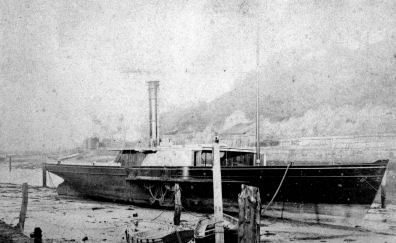
Queen Victoria as Swallow at Whitby
The railway was extended in 1858 so that through journeys from Glasgow were possible, and the company anticipated a substantial upturn in trade. They had Prince of Wales built and then Prince Consort in 1862, replacing the outdated Prince Albert. The Prince Consort had an unusual construction with her paddle sponsons extending the length of the hull to give greater deck space. She was also designed with wide deck saloons, found to be a great advantage, and saloons were also added a year or so later to the Prince of Wales.
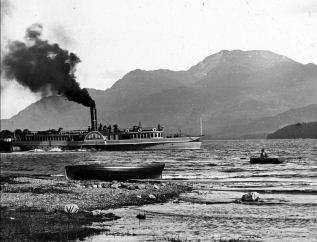
Prince of Wales in Loch Lomond Company Colours leaving Luss
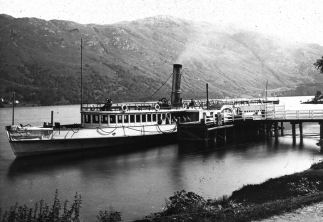
Prince Consort at Ardlui in Loch Lomond Company Colours. She appears to have used a sail on her way up the Loch.
The steamers suffered occasional mishaps, striking rocks and sustaining other damage that generally required a lengthy drown the Leven for repair. Surveys of the steamers' hulls was also problematic and in the late 1860s a slip dock was constructed just north of Luss Pier. The maintenance pier can be seen just behind the bow of Prince Consort in this photograph of Luss Pier.
When Queen Victoria was sold in 1866, she was replaced by Princess of Wales. Only one or two pictures of this steamer on the loch have been found but she had an extensive career on the Tay and elsewhere after she was sold in 1881. In 1869, the Loch was again graced by the monarch in mourning just eight years after the death of Prince Albert. On this occasion, Queen Victoria sailed on the Loch in Prince Consort and presented the company with a bronze bust of her late husband which was displayed in first-class cabin. She was apparently pleased with the trip.
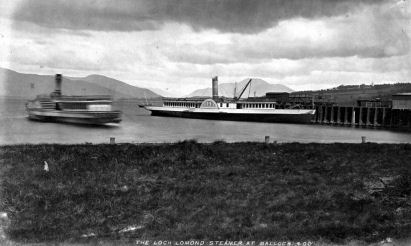
Prince of Wales at Balloch Pier with a blurry Princess of Wales
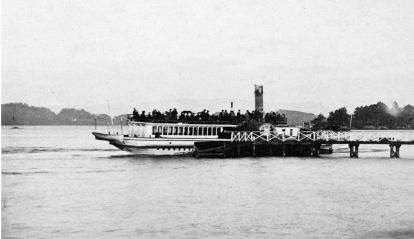
Princess of Wales at Luss Pier
The next addition to the Loch Lomond fleet was The Queen, built in 1883 to be the principal excursion steamer and allow the Prince of Wales to become the standby and winter boat now that Princess of Wales had left the Loch. She was an immediate success with her excellent saloon accommodation and became the prototype for subsequent steamers built for the Loch service. A further steamer, Empress, of similar but superior design was added by the Company in 1888. Before she could make her way up the Leven, however, the ownership of the steamers had changed.
The North British Railway Company operated both railway lines that terminated in Balloch and they negotiated to take over the Loch Lomond steamers. Accordingly, the assets of the Loch Lomond Steamboat Company were taken over by the North British Steam Packet Company on 31st October, 1888. At that time, the four steamers, Prince of Wales, Prince Consort, The Queen and the new Empress had new funnel colours: red with a black top and white band associated with the North British Clyde fleet although they retained the grey hull colour.
By this time the routes and calls of the steamers generally followed a criss-cross pattern up the Loch from Balloch, going first to Balmaha, then to Luss, back to Rowardennan, the starting point for climbing Ben Lomond, then to Tarbet where connections were made with steamers at Arrochar, to Inversnaid where connections were made with tours to Loch Katrine and the Trossachs, and on to Ardlui at the head of the Loch. On the return journey, the route was followed in reverse.
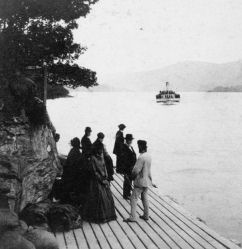
Waiting for Prince Consort at Inversnaid
The main commercial focus of the Loch Lomond steamers has always been the passenger and tourist traffic but from the 1840s onward, considerable freight and livestock traffic has also been important. Here sheep are loaded on a steamer at Inversnaid.
Heavier and more bulky goods were carried on Loch Lomond gabberts. Gabberts were barges equipped with one or two sails and were the most common commercial ships used on the Loch. At Luss there was considerable traffic in slates from the quarries. They were loaded on the shore at Camstradden.
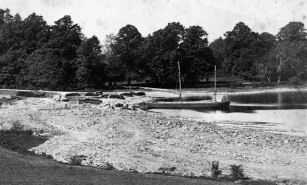
Gabbert loading slates at Camstradden Bay
Timber was also exported from various loch side sites. Logs were turned into pyroligneous acid, used in the textile trade, at the works at Balmaha or at Place of Bonhill. Timber was also taken for other purposes at Glasgow and other towns on the Clyde.
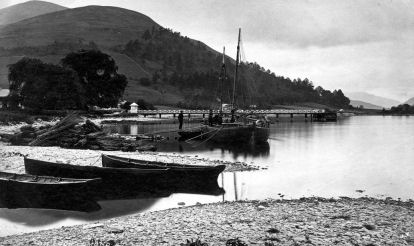
Gabbert Elizabeth loading coppiced wood for making bobbins for the thread works at Paisley
One of the best known of the gabbert men was Bill Russell whose little boat, Rob Roy, made regular trips up the Leven to deliver coal to the big houses on the Loch side. Bill was born in Renton in 1830 and died in 1906 and his obituary in the Lennox Herald in December of that year makes interesting reading. The family had been involved with traffic on the Forth and Clyde canal but has sold their scows or barges without sails, and settled in the Vale of Leven. Bill's brother, John Russell ran a steam lighter and was a coal merchant in Back Street, Renton. His mother was Mary McGregor whose father, Alex, a boatman from Kirkintilloch was a great grandson of Rob Roy himself. Bill was quite famous for his knowledge of the Loch and was a famous duck hunter. He featured on a number of postcards around the time of his death.
Steam lighters were also found on Loch Lomond but photographs of them are quite rare. In this picture a lighter is loading slates at Camstradden Bay.
Back to the steamers. The following pictures show the steamer The Queen at Balloch about to leave for her journey up the Loch and then at Inversnaid on her way down the Loch during the North British era.
The steamers continued to carry livestock and small goods to the loch side communities, and to undertake special excursions and duties. In this picture the Prince of Wales acts as Club Steamer for a regatta as The Queen heads up the Loch.
The North British monopoly of the Loch Lomond traffic incited its rival, the Caledonian Railway to propose its own route along the North bank of the Clyde from Glasgow to Dumbarton with an extension up the east side of the Vale of Leven to Jamestown and access to Loch Lomond by Kilmaronock and a pier at Aber. While the railway was built to Dumbarton, a compromise of equal joint ownership was reached for the Vale of Leven stretch and both companies had access to the existing Balloch Pier which was then extended to accommodate larger steamers. The agreement meant that both companies would also jointly own the steamers. The Caledonian Company reached Dumbarton in October 1896 and shortly thereafter the steamers came under the ownership of the Dumbarton and Balloch Joint Line Committee. A new funnel colour was introduced, red with a black top, and a new pennant displayed at the masthead.
The Dumbarton and Balloch Joint Line Committee, served by two railways, experience an increase in passenger traffic and steps were taken to replace the aging Prince Consort and Prince of Wales. Late in 1898, the two new steamers, Prince George and Princess May, arrived on the Loch. Both steamers had saloons the full width of their hulls and though not much longer than The Queen and Empress, they were larger than their older fleetmates and both experienced significant difficulty in the trip up the Leven.
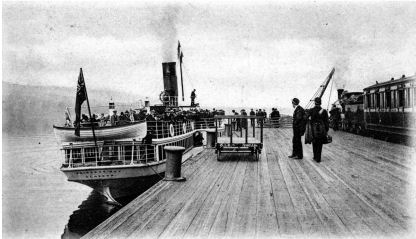
Princess May at Balloch Pier connecting with a Caledonian train
The disposal of the older members of the fleet was quickly arranged. Prince Consort was sold before the end of 1898 and Prince of Wales the year after. The new steamers were kept busy and presented a very attractive scene on the Loch. Problems with the decayed state of the slip-dock at Luss prompted the construction of a new, larger slip at Balloch in 1902.
By 1909, there was concern for the poor state of the The Queen and a replacement steamer was considered. A vessel was eventually ordered and though delayed in building, she was launched in March, 1911. Named Prince Edward, she was similar to Prince George and Princess May but fully 10 feet longer and there concerns about whether she could be taken up the Leven.
As it turned out, the concerns were justified and in May, without her funnel but under power and hauled by both horses and men on both banks, she began her journey to the Loch. When the water level dropped, she grounded in several places but eventually stuck fast at Kirkland in Bonhill. There she remained over the lucrative summer period until November when the level of the river allowed her to proceed to Balloch where she was repaired and finished to allow her to enter service the next year. In the meantime, The Queen was sold.
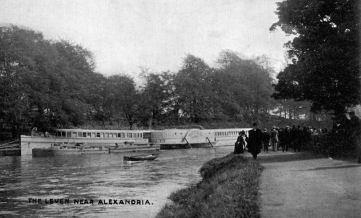
Prince Edward stranded at Kirkland
The Company took advantage of the demise of the City Steam-Boat Company of London in 1914 to purchase two small steamers for use on short excursions and the unprofitable winter service. The steamers, Shakespeare and Earl Godwin were renamed Princess Patricia and Queen Mary respectively and they arrived on the Loch in time for the summer season. The Princess Patricia was the first to be modified for service on the Loch but Queen Mary caught fire and was left derelict in Drumkinnon Bay until she was sold for scrap in 1928 and never did enter service.
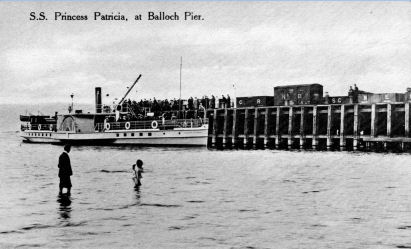
Princess Patricia at Balloch Pier
Steamer services continued during the first world war and at the end of hostilities there was a great upsurge in business as troops returning to their home countries visited Scotland's most famous Loch.
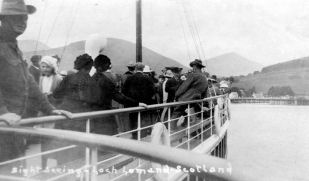
Australian troops on Prince Edward approaching Luss Pier in 1918
The boom was not to last. The consolidation of the railway companies in 1923 led to a rationalisation of resources and the addition of a new, larger house-flag, with LMS and LNER prominently displayed, for the fleet.
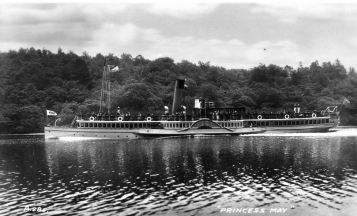
Princess May with the LMS/LNER house-flag
Empress was laid up in 1925 and eventually was sold in 1933. Winter services, unable to compete with road transport were withdrawn in 1933 but the smaller fleet continued to serve the summer tourist traffic with Princess Patricia offering short cruises and the other steamers sharing the principal service.
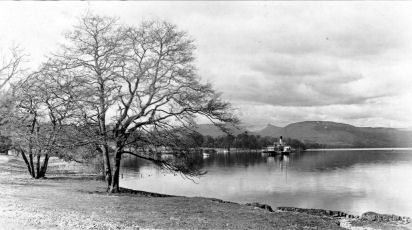
Empress laid up in Drumkinnon Bay.
Just beyond her stern can be seen the stern of Queen Mary.
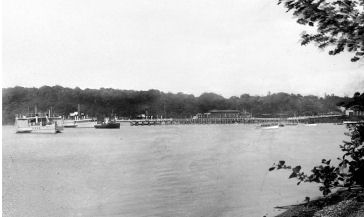
Three of the fleet, Princess Patricia, Princess May and Prince Edward at Balloch in 1928. The repair jetty, slip and engine house can be seen
Princess Patricia was sold at the end of 1938 and Prince George was laid up the next year. When hostilities broke out in 1939, the intention was to continue the service with Prince Edward and Princess May but all three of the steamers were requisitions as accommodation vessels. Prince George was broken up in 1942. The remaining steamers survived the war and were refurbished, enjoying a brief increase in trade before nationalisation in 1947.
On nationalisation, the steamers changed their funnel colours to those of the British Railways Clyde fleet, yellow with a black top, and their hulls were painted black. However, both steamers were ageing and the decision was made to replace them with a large steamer, one that was too large to be brought up the Leven and would require final assembly on the Loch side.
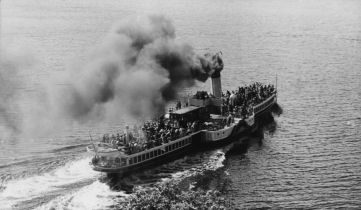
Princess May leaving Balmaha in British Railways colours.
The Maid of the Loch entered service in May 1953 and shortly thereafter, the Princess May was broken up at Balloch. Prince Edward received yet another new colour scheme, matching Maid of the Loch with a yellow funnel and all-white hull. Smoke from her old boilers left an untidy stain on the funnel and she eventually had a narrow black band painted at the top. In April 1955, she too succumbed to the breaker's hammer leaving Maid of the Loch as the sole Loch Lomond Steamer.
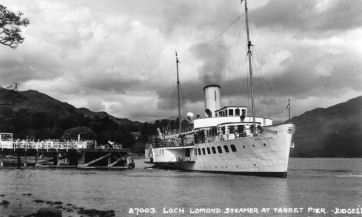
Maid of the Loch at Tarbet Pier
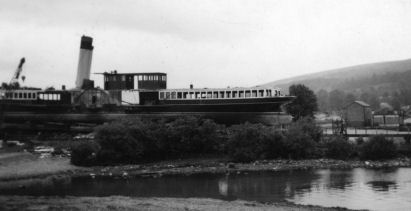
Princess May being broken up at Balloch
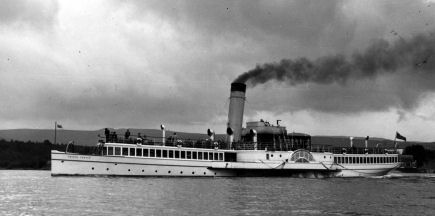
Prince Edward in her last season at Balloch
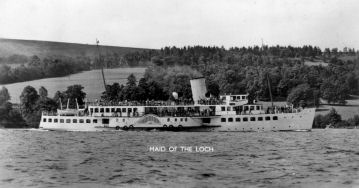
Maid of the Loch approaching Balloch
The Maid was never the success that was envisioned with her larger size. Eventually she was sold and laid up at Balloch Pier in 1982 and allowed to decay. Efforts to bring her back to her former glory are well advanced but have yet to reach fruition.
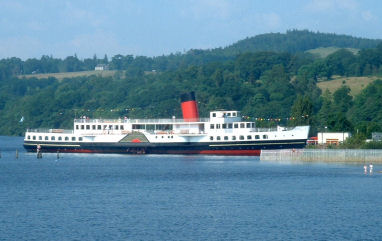
The Maid of the Loch Today, under restoration.
Approval in principle has been granted, which would allow the Maid of the Loch to sail again if and when she is made capable of doing so. The Loch Lomond Steamship Company has been created by the volunteers who are helping to restore her. You can keep up to date with progress and developments on their website, http://www.maidoftheloch.org/
Note: Sailing on Loch Lomond has continued during the last few years courtesy of Sweeney's Cruises, which operates several vessels including the largest still sailing on the Loch, the "Astina". Their other large vessel, the "Silver Marlin" has over the years has been a popular venue for wedding, and other functions.
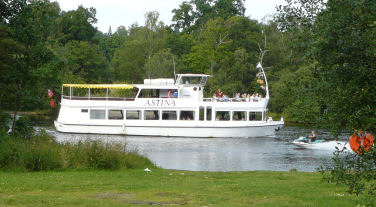
The Astina on the River Leven at Balloch
References:
D. Macleod, History of Lochlomond Steamboat Companies, Bennet & Thompson, Dumbarton, 1888.
C. L. D. Duckworth and G. E. Langmuir, Clyde River and Other Steamers, Brown, Son and Ferguson, Glasgow , 1972.
A. Brown, Loch Lomond Passenger Steamers 1818-1989, Alan T. Contie, Nuneaton, 2000.
P. J. G. Ransom, Steamers of loch Lomond, Stenlake, Catrine, 2007

